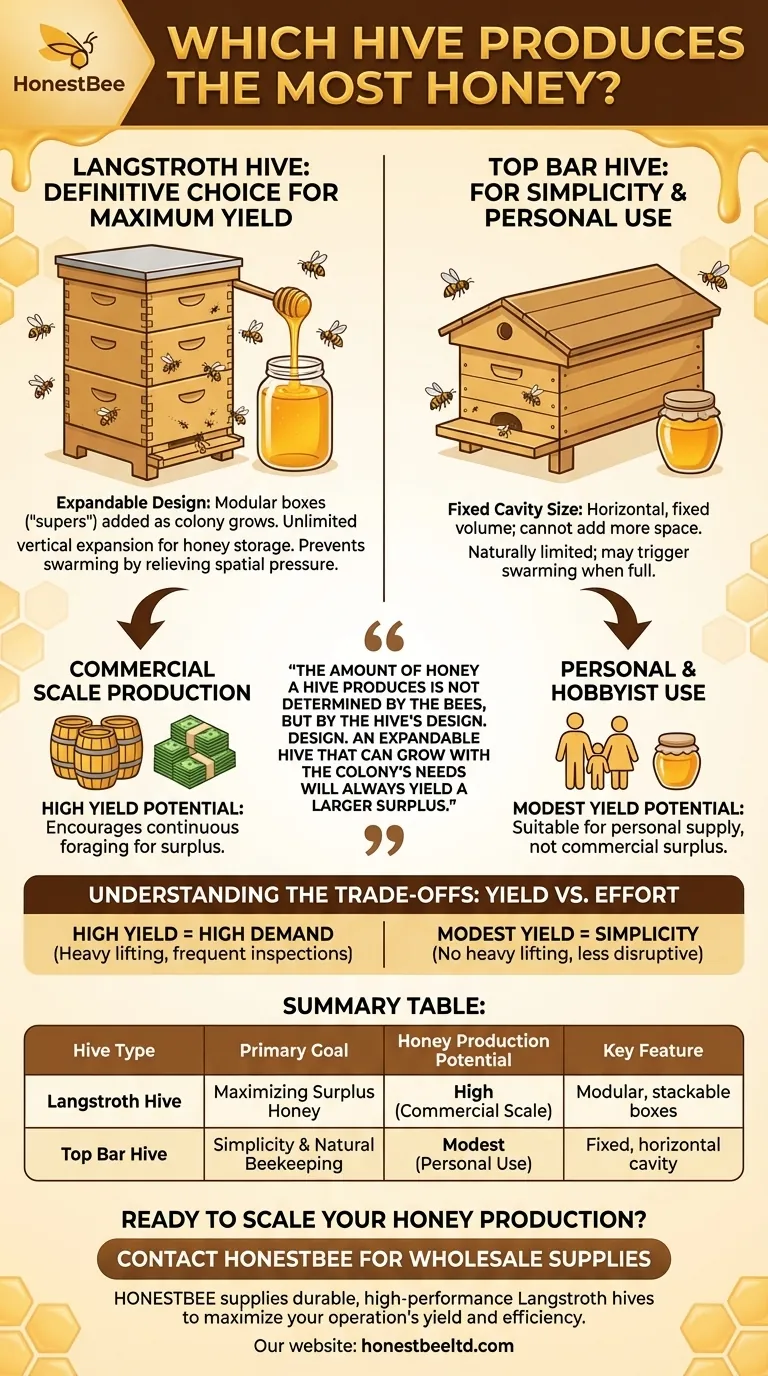For maximizing honey production, the Langstroth hive is the definitive choice. This design is fundamentally built for expansion, allowing beekeepers to add space as the colony grows and nectar flows. In contrast, hives with a fixed cavity size, like the Top Bar hive, will produce a more modest harvest suitable for personal use.
The amount of honey a hive produces is not determined by the bees, but by the hive's design. An expandable hive that can grow with the colony's needs will always yield a larger surplus than a hive with a fixed volume.

Why Hive Design Dictates Honey Production
A honeybee colony's primary instinct is to survive and reproduce. A beekeeper's goal is to manage this instinct to encourage the production of surplus honey. The hive's structure is the most critical tool for achieving this.
The Principle of Expandability
The key advantage of the Langstroth hive is its modular, expandable design. It consists of stackable boxes, known as "supers."
As the bee population grows and nectar becomes abundant, you can simply add more supers on top. This provides nearly limitless space for the bees to store honey.
This vertical expansion tricks the colony into thinking it has infinite resources, encouraging them to continuously forage and produce far more honey than they need for their own survival.
Preventing Swarming
When a colony feels crowded in a fixed-size cavity, its natural response is to swarm. The queen leaves with half the workforce to find a new home.
Swarming dramatically reduces honey production because the hive loses a significant portion of its foragers. The Langstroth's ability to expand relieves this spatial pressure, reducing the likelihood of swarming and keeping the workforce focused on honey collection.
A Head-to-Head Comparison
While both hive types will produce honey, they are engineered for fundamentally different outcomes.
The Langstroth: Engineered for Surplus
The Langstroth hive is the standard for commercial beekeeping for a reason. Its design is optimized for efficiency and maximum yield.
Its components are standardized, and the ability to add supers during a strong nectar flow allows a healthy colony to produce a very large quantity of honey.
The Top Bar Hive: A Self-Contained System
A Top Bar hive has a fixed, horizontal cavity. The bees build their comb down from removable bars, but you cannot add more space.
This fixed volume means the colony will eventually fill the available space, which can trigger swarming. It will still produce a harvest, but it is naturally limited—perfect for a beekeeper who wants enough honey for their family and friends without complex management.
Understanding the Trade-offs: Yield vs. Effort
Choosing a hive is not just about potential honey yield; it's also about your goals and the level of management you're willing to undertake.
The Langstroth: Higher Yield, Higher Demands
While the Langstroth offers the highest potential reward, it also requires more work. The boxes can become extremely heavy, and managing multiple supers requires more lifting and inspection time.
This makes it the ideal choice for beekeepers who are serious about honey production, whether for a small business or a large personal supply.
The Top Bar: Simplicity Over Scale
The Top Bar hive is often favored for its simplicity. Inspections are less disruptive, and there is no heavy lifting of supers.
The trade-off is a smaller honey harvest. This hive is better suited for the hobbyist whose goal is bee wellness and a modest personal supply of honey, rather than sheer production volume.
Making the Right Choice for Your Goal
Your beekeeping goals should be the deciding factor in your choice of hive.
- If your primary focus is maximizing honey yield: The Langstroth hive is the only logical choice due to its superior expandability and management options.
- If your primary focus is a less intensive, more natural approach with a modest honey harvest: The Top Bar hive provides a simpler and more manageable beekeeping experience.
Ultimately, select the hive that best aligns with the amount of honey you desire and the level of work you are prepared to invest.
Summary Table:
| Hive Type | Primary Goal | Honey Production Potential | Key Feature |
|---|---|---|---|
| Langstroth Hive | Maximizing Surplus Honey | High (Commercial Scale) | Modular, stackable boxes for unlimited expansion |
| Top Bar Hive | Simplicity & Natural Beekeeping | Modest (Personal Use) | Fixed, horizontal cavity; limited space |
Ready to Scale Your Honey Production?
For commercial apiaries and beekeeping equipment distributors, the right equipment is the foundation of success. HONESTBEE supplies the durable, high-performance Langstroth hives and beekeeping supplies you need to maximize your operation's yield and efficiency through our wholesale-focused operations.
Contact our expert team today to discuss your wholesale needs and discover how we can help your business thrive.
Visual Guide

Related Products
- Langstroth Bee Hives Bee Keeping Box for Beginners Beekeeping
- Long Langstroth Style Horizontal Top Bar Hive for Wholesale
- HONESTBEE Professional Multi-Functional Hive Tool with Ergonomic Wood Handle
- HONESTBEE Advanced Ergonomic Stainless Steel Hive Tool for Beekeeping
- HONESTBEE Professional Long Handled Hive Tool with Precision Cutting Blade
People Also Ask
- What is the best type of bee hive for beginners? Start with the Proven Langstroth Standard
- What are the key features of the Langstroth beehive? A Guide to the Standard for Modern Beekeeping
- Why were wooden hives traditionally preferred? For Natural Beekeeping Aligned with Bee Biology
- Should a beginner try a different type of hive? Start with a Langstroth for a solid foundation.
- How does the ease of access differ between 8-frame and 10-frame hives? Choose the Right Hive for Your Body



















